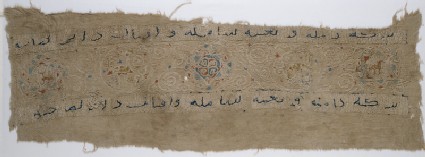Browse: 154 objects
- Reference URL
Actions
Textile fragment with naskhi inscription, birds, and palmettes
-
Details
- Associated place
-
Near East (place of creation)
- Date
-
12th century (1101 - 1200)
Fatimid Period (AD 909 - 1171)
- Material and technique
- linen, embroidered with blue and undyed flax, and red and yellow silk
- Dimensions
-
63 x 21 cm (length x width)
along length/width 20 / 20 threads/cm (thread count)
embroidery band 13 cm (width)
ground fabric 0.03 cm min. (thread diameter)
ground fabric 0.05 cm max. (thread diameter)
additional fibre, embroidery 0.1 cm (thread diameter)
- Material index
-
organic › animal › animal product › silk,
- Technique index
-
assembled › woven › plain woven,woven › plain woven,
- Object type index
- No. of items
- 1
- Credit line
- Presented by Professor Percy Newberry, 1941.
- Accession no.
- EA1984.104
-
Further reading
Ellis, Marianne, Embroideries and Samplers from Islamic Egypt (Oxford: Ashmolean Museum, in association with Greenville: Curious Works Press, 2001), no. 5 on p. 16, illus. pp. 16-17
Barnes, Ruth and Marianne Ellis, ‘The Newberry Collection of Islamic Embroideries’, 4 vols, 2001, Oxford, Ashmolean Museum, cat. vol. ii, vol. i p. 20 n. 6, illus. vol. i
Location
-
- currently in research collection
Objects are sometimes moved to a different location. Our object location data is usually updated on a monthly basis. Contact the Jameel Study Centre if you are planning to visit the museum to see a particular object on display, or would like to arrange an appointment to see an object in our reserve collections.
Galleries
Publications online
-

Embroideries and Samplers from Islamic Egypt
Fortunately the whole of the embroidered part of this textile has survived but, in common with most of the pieces in the collection, the surrounding cloth has been cut away, so we can only speculate as to its original size and use. The linen is fine enough for a shawl and the text of the inscription implies that it was a personal possession reading “Perfect blessing, complete contentment and continuing prosperity to its owner". Because it is written in the cursive naskhi script, it is likely to be from the late Fatimid era. The bold design is very striking with its eight-pointed stars and birds in roundels surrounded by scrolls. Some lustre-painted jars and bowls from Fatimid Egypt also have rosettes containing four inward facing heart-shaped palmettes, and single birds with scrolls springing from their beaks like the peacock on this band.
The outlines were defined by couching down thick linen thread and then adding brightly coloured silk to fill in the details. For the letters, blue silk has been set into a dense white background of couched threads. This particular method of couching down threads is one more commonly used for metal-thread embroidery, where it is impractical to take the thread through the ground fabric. This example could be a cheaper version of couched thread embroidery worked with similar designs but using metal threads, as illustrated in an article by Wiet, ‘Ars Islamica IV’, 1937. -

The Newberry Collection of Islamic Embroideries
A wide band is filled with five roundels; the two outer ones each hold a small bird inside a star shape, the two adjacent ones have a single yellow and red bird surrounded by scrolls, and the central roundel has an eight-pointed blue star with four individual blue and red scrolls at the centre. The roundels are surrounded by scrolling vines embroidered in white couching stitch. Along top and bottom of the band are two bands with identical inscriptions.
The band is 13 cm wide.
The radiocarbon date is 942 AD +/- 35; stylistically the piece belongs to the Fatimid era.
© 2013 University of Oxford - Ashmolean Museum





